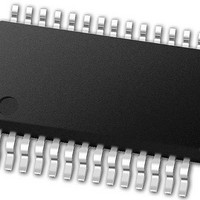PIC24FJ64GB002-I/SS Microchip Technology, PIC24FJ64GB002-I/SS Datasheet - Page 201

PIC24FJ64GB002-I/SS
Manufacturer Part Number
PIC24FJ64GB002-I/SS
Description
16-bit, 16 MIPS, 64KB Flash, 8KB RAM, Nanowatt XLP, USB OTG 28 SSOP .209in TUBE
Manufacturer
Microchip Technology
Specifications of PIC24FJ64GB002-I/SS
Processor Series
PIC24
Core
PIC24F
Data Bus Width
16 bit
Program Memory Type
Flash
Program Memory Size
64 KB
Data Ram Size
8192 B
Interface Type
I2C, SPI, UART
Maximum Clock Frequency
32 MHz
Number Of Programmable I/os
21
Number Of Timers
5
Operating Supply Voltage
2 V to 3.6 V
Maximum Operating Temperature
+ 85 C
Mounting Style
SMD/SMT
Package / Case
SSOP-28
Development Tools By Supplier
MPLAB Integrated Development Environment
Minimum Operating Temperature
- 40 C
Operating Temperature Range
- 40 C to + 85 C
Supply Current (max)
300 mA
Lead Free Status / Rohs Status
Lead free / RoHS Compliant
Available stocks
Company
Part Number
Manufacturer
Quantity
Price
Part Number:
PIC24FJ64GB002-I/SS
Manufacturer:
MICROCHIP/微芯
Quantity:
20 000
- Current page: 201 of 352
- Download datasheet (3Mb)
18.1.2.3
When operating as a USB host, either as an A-device
in an OTG configuration or as an embedded host, V
must
PIC24FJ64GB004 family devices have an internal
V
V
comprised of a simple PWM output to control a
switch-mode power supply, and built-in comparators to
monitor output voltage and limit current.
To enable voltage generation:
1.
2.
3.
4.
5.
6.
7.
EQUATION 18-1:
2010 Microchip Technology Inc.
BUS
BUS
Note:
Legend: V
Verify that the USB module is powered
(U1PWRC<0> = 1) and that the V
is disabled (U1OTGCON<0> = 0).
Set the PWM period (U1PWMRRS<7:0>) and
duty cycle (U1PWMRRS<15:8>) as required.
Select the required polarity of the output signal
based on the configuration of the external circuit
with the PWMPOL bit (U1PWMCON<9>).
Select the desired target voltage using the
VBUSCHG bit (U1OTGCON<1>).
Enable the PWM counter by setting the CNTEN
bit to ‘1’ (U1PWMCON<8>).
Enable the PWM module by setting the PWMEN
bit to ‘1’ (U1PWMCON<15>).
Enable
(U1OTGCON<3> = 1).
from the available voltages on the board. This is
boost assist to help generate the required 5V
be
This
process for V
control. Please refer to the “PIC24F
Family Reference Manual” for additional
examples.
supplied
V
External Devices
P
of ‘0’.
P
L
applications use cables no longer than 5m.
I
cable.
PULLUP
CABLE
BUS
USB
ZERO
IN
the
– Percentage (in decimal) of total bus bandwidth that is used for IN traffic.
section
– Voltage applied to the V
Voltage Generation with
– Percentage (in decimal) of the IN traffic bits sent by the PIC
– Length (in meters) of the USB cable. The USB 2.0 Specification requires that full-speed
– Current which the nominal, 1.5 k pull-up resistor (when enabled) must supply to the USB
V
ESTIMATING USB TRANSCEIVER CURRENT CONSUMPTION
BUS
to
BUS
describes
the
voltage generation and
I
XCVR
generation
attached
=
BUS
(40 mA • V
the
discharge
USB
general
circuit
device.
pin in volts (3.0V to 3.6V).
USB
PIC24FJ64GB004 FAMILY
BUS
(3.3V • 5m)
• P
ZERO
• P
18.1.3
Some applications may require the USB interface to be
isolated from the rest of the system. PIC24FJ64GB004
family devices include a complete interface to commu-
nicate with and control an external USB transceiver,
including the control of data line pull-ups and
pull-downs. The V
can also be configured for different V
topologies.
Please refer to the “PIC24F Family Reference Manual”,
”Section 27. USB On-The-Go (OTG)” for information
on using the external interface.
18.1.4
The USB transceiver consumes a variable amount of
current depending on the characteristic impedance of
the USB cable, the length of the cable, the V
voltage and the actual data patterns moving across the
USB cable. Longer cables have larger capacitances
and consume more total energy when switching output
states. The total transceiver current consumption will
be
estimate how much current actually may be required in
Full-speed applications.
Please refer to the “PIC24F Family Reference Manual”,
”Section 27. USB On-The-Go (OTG)” for a complete
discussion on transceiver power consumption.
IN
• L
application-specific.
CABLE
USING AN EXTERNAL INTERFACE
CALCULATING TRANSCEIVER
POWER REQUIREMENTS
)
+ I
PULLUP
BUS
®
microcontroller that are a value
voltage generation control circuit
Equation 18-1
DS39940D-page 201
BUS
USB
generation
can
supply
help
Related parts for PIC24FJ64GB002-I/SS
Image
Part Number
Description
Manufacturer
Datasheet
Request
R

Part Number:
Description:
Manufacturer:
Microchip Technology Inc.
Datasheet:

Part Number:
Description:
Manufacturer:
Microchip Technology Inc.
Datasheet:

Part Number:
Description:
Manufacturer:
Microchip Technology Inc.
Datasheet:

Part Number:
Description:
Manufacturer:
Microchip Technology Inc.
Datasheet:

Part Number:
Description:
Manufacturer:
Microchip Technology Inc.
Datasheet:

Part Number:
Description:
Manufacturer:
Microchip Technology Inc.
Datasheet:

Part Number:
Description:
Manufacturer:
Microchip Technology Inc.
Datasheet:

Part Number:
Description:
Manufacturer:
Microchip Technology Inc.
Datasheet:











